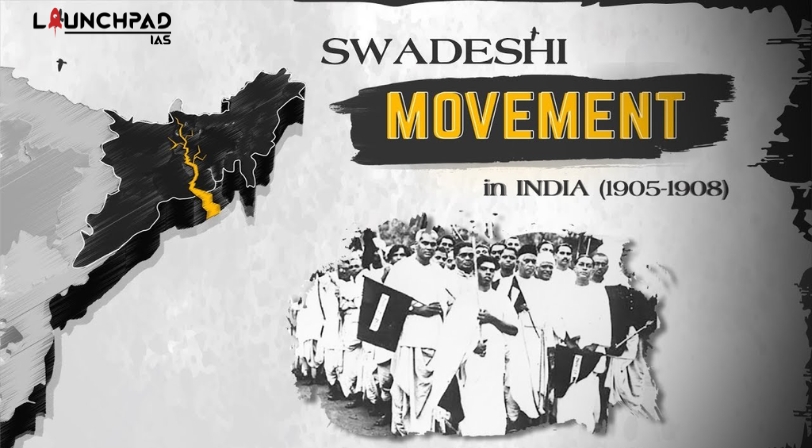Background:
- The movement had its roots in the anti-partition movement which was started to oppose Lord Curzon’s decision of dividing the province of Bengal.
- The Anti-Partition Campaign was launched by Moderates to exert pressure on the government to prevent the unjust partition of Bengal from being implemented.
- The petitions were written to the government, public meetings were held and the ideas were spread through newspapers such as Hitabadi, Sanjibani, and Bengalee.
- The partition led to protest meetings in Bengal under which the pledge to boycott foreign goods was first taken.
Swadeshi Movement Proclamation:
- In August 1905, at Calcutta Townhall, a massive meeting was held and the formal proclamation of the Swadeshi Movement was made.
- The message was propagated to boycott goods such as Manchester cloth and Liverpool salt.
- After the partition came into force, widespread opposition was shown by the people of Bengal by singing Vande Mataram.
- Rabindranath Tagore also composed Amar Sonar Bangla.
- People tied Rakhis on each other’s hands as a symbol of unity.
- Although the movement was confined majorly to Bengal, it spread to a few different parts of India:
- In Poona and Bombay under Bal Gangadhar Tilak
- In Punjab under Lala Lajpat Rai and Ajit Singh
- In Delhi under Syed Haider Raza
- In Madras under Chidambaram Pillai.
Congress Reaction:
- The Indian National Congress (INC) in a meeting in 1905 resolved to condemn the partition of Bengal and support the anti-partition and Swadeshi Movement.
- The radical nationalists wanted the movement to be taken outside Bengal and go beyond just the boycott of foreign goods.
- However, the moderates, dominating the Congress, were unwilling to go that far.
- In the 1906 Congress Session held at Calcutta, the INC under the presidentship of Dadabhai Naoroji declared self-government or Swaraj as the goal of the INC.
Rise of the Radical Nationalists:
- The Extremists (or the Garam Dal) gained a dominant influence over the Swadeshi Movement in Bengal from 1905 till 1908; it is also known as the “Era of Passionate Nationalists”.
- Lala Lajpat Rai, Bal Gangadhar Tilak, and Bipin Chandra Pal (Lal-Bal-Pal) were important leaders of this Radical group.
- The reasons for the same were:
- Failure of the Moderate-led Swadeshi movement.
- Divisive tactics of the governments of East Bengal and Western Bengal.
- Violent measures of the British to suppress the movement.
- In addition to boycotting the Extremists gave a call for boycotting government schools and colleges, government service, courts, legislative councils, municipalities, government titles, etc.
- Tilak gave the slogan “Freedom is my birthright and I shall have it”.
Participation of People:
- Students: School and college students were the most active participants of the movement.
- Student participation was visible in Bengal, Poona (Maharashtra), Guntur (Andhra Pradesh), Madras and Salem (Tamil Nadu).
- The police adopted a repressive attitude towards the students. The students found guilty were fined, expelled, beaten, arrested, and disqualified for government jobs and scholarships.
- Women: Traditionally home-centered women too took an active part in the movement.
- Stand of Muslims: Some of the Muslims participated, however, most of the upper and middle-class Muslims stayed away.
- They supported the partition on the belief that it would provide them a Muslim-majority East Bengal.
Evaluation of the Swadeshi Movement
- It led to the beginning of the organized political movement in India.
- It marked a total reversal of the earlier nationalist approach of “petitioning and praying” to the Raj for concessions, as well as a virtual rejection of the moderate political program.
- It set before the Indian people the goal of Swaraj or independence and committed them to the task of doing away with Britain’s imperialist stranglehold over India.
- In the pursuit of Swaraj, it advocated “passive resistance” or civil disobedience against British authority, placing constitutionalism in a secondary role.
The Swadeshi movement, although not a full-fledged mass uprising, exhibited some secretive aspects and revealed certain weaknesses. However, it achieved significant success in terms of ideology, organisation, and political strategies.
Related Links: Atma Nirbhar Bharat


